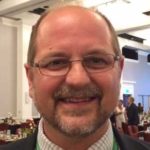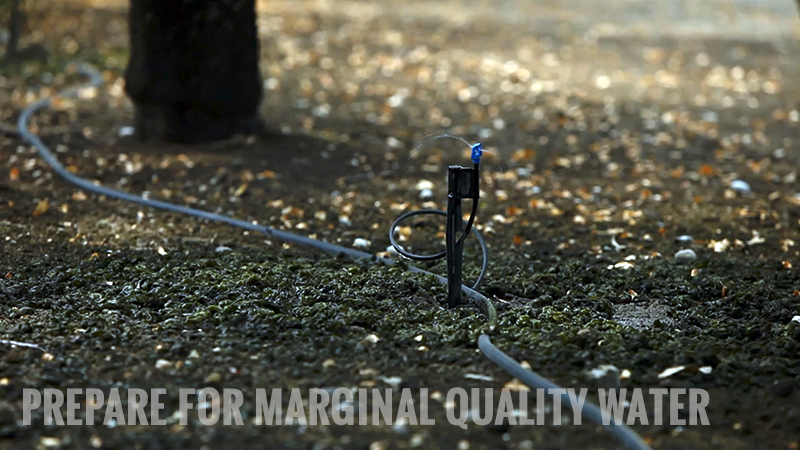Clean Citrus Budwood the Product of Solid Team Effort

[From left] FDACS/DPI Bureau of Citrus Budwood team members include Justin Ezell, Kristin Helseth, and Ben Rosson.
Photo courtesy of FDACS/DPI
The Florida Department of Agriculture and Consumer Services’ Division of Plant Industry’s Bureau of Citrus Budwood Registration (the Bureau) administers a program to assist growers in producing citrus nursery trees believed to be horticulturally true to varietal type, productive, and free from certain recognizable bud-transmissible diseases detrimental to fruit production and tree longevity.
This is the 64th year of the Citrus Budwood Registration Program. Clean stock emerging from certification programs is the best way to avoid costly disease catastrophes in young plantings and their spread to older groves. Certification programs also restrict or prevent pathogens from quickly spreading within growing areas. Regulatory endeavors have better prospects of containing or eradicating new disease outbreaks if certification programs are in place to control germplasm movement.
Budwood registration has the added benefit of allowing true-to-type bud lines to be propagated. The selection of cultivars for clonal propagation gives growers uniform plantings of high-quality trees. The original mother stock selected for inclusion in the Florida budwood program is horticulturally evaluated for superior performance, either by researchers, growers, or Bureau staff. Horticultural evaluation is just as vital to the success of the program as pathogen testing of budwood sources.
The Bureau’s core team quietly performs these valuable functions, mostly out of sight of the mainstream citrus industry.
The Bureau’s Three Facilities
1. The Chiefland Budwood Foundation receives clean parent material from both the in-state and out-of-state Citrus Germplasm Introduction Program for production and distribution of bud eyes to certified commercial citrus nurseries and research agencies.
The facility employs six staff members including Bureau chief, administrative secretary, greenhouse operations manager, and caretakers.
2. LaCrosse Citrus Repository receives out-of-state and out-of-country material for cleanup and introduction into Florida. All testing of new introductions and yearly scion tree testing is done here. It also will be a backup for the Chiefland facility in the future.
The Facility employs nine people, including bio-administrator for the Citrus Germplasm Introduction Program, lab director and staff for testing and certification, greenhouse caretakers, and shoot-tip grafting and indicator budding tech.
3. Winter Haven receives dirty material from in-state introductions and shoot-tip grafts it for cleanup and eventual transport to LaCrosse where it will be grown out. The facility collects initial samples for testing of new introductions and sends to LaCrosse for analysis. Citrus Nursery Inspection is based out of this office due to the proximity of our citrus nurseries. This office handles all Bud Cutting Reports as well as scion tree
planting information.
The facility employs 13 people, including the assistant Bureau Chief, a data analyst, citrus nursery inspectors, lab workers, shoot tip grafting techs, scion tree inspector, and greenhouse caretakers.
I had a chance to interview the three core people responsible for the program: Ben Rosson, Bureau Chief; Justin Ezell, Assistant Chief, Bureau of Budwood Registration; and Kristen Helseth, Biological Scientist IV and Manager of the Florida Citrus Repository.
Ben Rosson
Originally from: Plant City, FL
Education: Citrus/Business from Florida Southern College; Master of Science in Management from Argosy University
Work history highlights:
- Managed three groves with Kahn Citrus Management
- Started with Department in 2006
- Supervised construction and expansion of Chiefland Budwood Foundation
- Supervised construction of Phase 2 at LaCrosse
- Became Bureau Chief in 2016
Family: Married with two boys (ages 7 and 1)
Hobbies: Camping, running, and spending time with family
Justin Ezell
Originally from: Winter Haven, raised in Avon Park
Education: University of Florida, Bachelor of Science in Food and Resource Economics
Work history highlights:
- Involvement in rulemaking of 5B-62
- Development and implementation of citrus nursery regulations and inspection protocols
Family: Married 14 years to Lisa Ezell, who owns and runs a veterinary clinic. We have twin 10-year-old daughters (Audra and Kayla) and two Boston terriers (Riley and Caiden).
Hobbies: Spend time with family and friends. Enjoy being out on or near the water.
Kristen Helseth
Originally from: Ft. Pierce, FL
Education: B.S. Horticulture Science from Florida Southern College; M.S. Environmental Science from University of Florida
Work history highlights:
- Manager of the Florida Citrus Repository – FDACS DPI in LaCrosse; managing facility and introduction process from introduction to release
- Biological Scientist – FDACS DPI; Shoot-Tip Grafting, biological indexing, etc.
- Lab Tech – USDA ARS/HRL in Ft. Pierce; HLB diagnostician
- Lab Tech – USDA ARS/HRL; tissue culture
- Worked for family citrus business as a teenager during summers
Family: Two daughters (ages 8 and 4)
Hobbies: Enjoy spending time with family, gardening, and cooking.
What are your biggest challenges at the Bureau?
Rosson: The anticipation of new varieties and providing the large volume of material that industry is requesting. My crystal ball has been broken for a long time. Other challenges are material coming from a field or greenhouse, not a foundation house, and the extra time involved in testing and cleaning up the material.
Ezell: Not knowing today what variety may become the next best thing tomorrow because growers hear about it through a researcher or elsewhere, and suddenly everybody wants it, and our ability to respond is limited.
Helseth: My challenges involve trying to get material through in a timely manner, knowing the industry needs it so badly. When we get the dirty material in, we try to clean it up as soon as possible to meet the growing demand.
What is your vision for the future?
Rosson: To be able to supply the industry with the cleanest material available in a timely manner. We’re looking for new technologies that will accelerate our clean-up processes.
Helseth: One thing we’re working on is a new tissue culture method that we want to implement as soon as possible. It pretty much eliminates the need to re-shoot-tip graft and will save months on the process. If there is a limited supply of budwood, this proposed method will allow us to make significantly more in-vitro propagations for shoot-tip grafting, rather than relying on greenhouse parent material to grow out.
What is new, what will change, and what will stay the same?
Rosson: What’s new and will change are new utilization of technologies, protocols, and procedures that will enhance our ability to meet industry needs. What will stay the same is we will still provide the same quality that we always have. We’ll still be willing to explore every course of action to meet industry demands in a timelier manner.
What will be the impact of changes on how the Bureau interacts with the industry and the way selections are processed?
Rosson: The Bureau will be more responsive to industry; we’ll have a better handle on what they’re feeling and seeing. One thing we’re doing is consolidating our out-of-state and in-state operations into one location, giving our bio-administrator [Kristen] responsibility over these combined operations making sure nothing slips through the cracks — ensuring that all the testing is getting done. New testing methods will be more precise and also will protect the program’s integrity.
Ezell: We are interacting more than ever with industry. We’re out there with our ears to the ground, attending orange trials, talking with researchers first hand instead of just reading about issues online. We are much more engaged in the field; it seems like we’re in the field or attending a citrus-related event every week.
Helseth: Another thing we’re looking at is incorporating molecular indexing. Instead of only relying on symptom expression as with traditional biological indexing, we also will conduct laboratory testing on the indicators for all pathogens that are currently on the indexing panel.
What is happening with capacity?
Rosson: The capacity of the program is increasing. We have room in the program for more introductions because we’re finally getting our positions filled. With new, more precise testing techniques, we’re able to get things through resulting in increased turn-around times without sacrificing safety.
Helseth: With the addition of molecular indexing, we can reduce the indicator panel down to two varieties, which significantly reduces the amount of inoculum needed for indexing. We need less testing material going forward due to our focus on more precise sampling and testing techniques.
What’s new with nursery inspections?
Ezell: Nursery inspections are status quo, but that’s a good thing. What we’ve learned in the past 10 years is that the structures work at keeping stock disease free — to such a degree that they’re keeping canker out as well. Unfortunately, it’s people who are the greatest risk to spreading canker. We have added a lot more nurseries that want to ship out of state. Currently, there are 10 nurseries certified to ship out of state. In all, we have 76 certified citrus nurseries — 47 of those are commercial. It’s working, except when a hurricane comes. And even then, as evidenced by Hurricane Irma, we worked through it.
Author note: Special thanks to FDACS’ DPI and the Bureau of Citrus Budwood registration for their contributions to this article. And special recognition goes out to Michael Kesinger and Dr. Peggy Sieburth, recently retired from the Bureau. They were good friends to the citrus industry and their many years of service are greatly appreciated.










